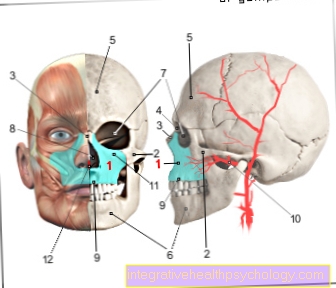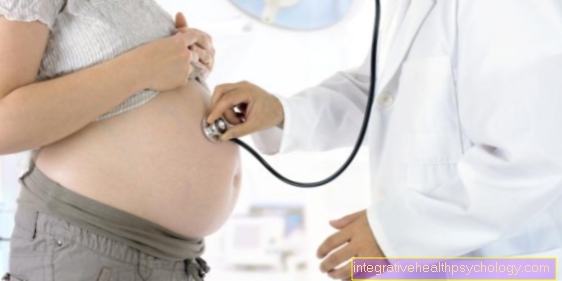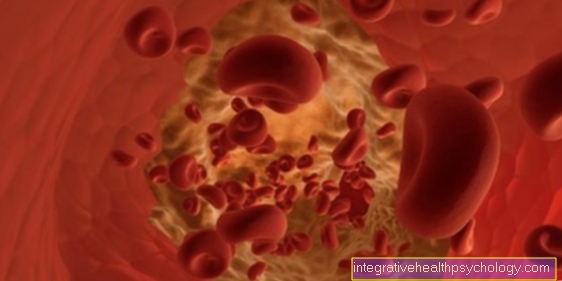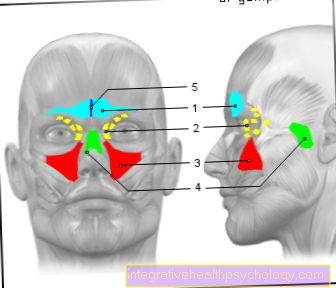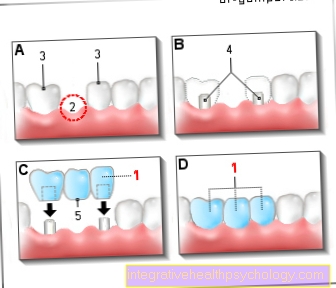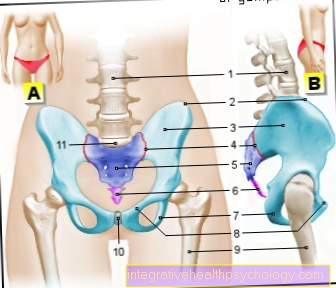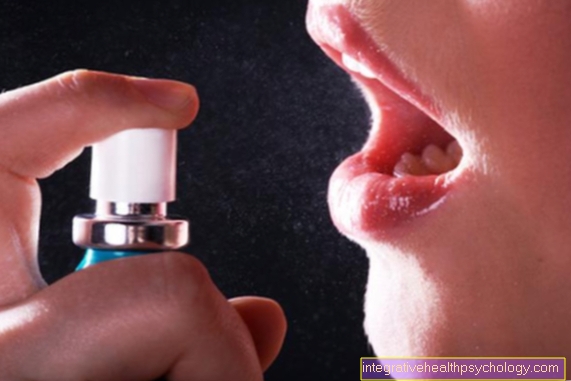Ovarian inflammation
Technical term
Adnexitis
Synonyms
Inflammation of the ovaries
Synonyms in a broader sense
Oophorosalpingitis
definition
Inflammation of the ovaries (adnexitis) is a gynecological disease that is characterized by the presence of inflammatory processes in the area of the ovaries. In medical terminology, the term “adnexitis” usually means a combination of inflammation of the ovaries and the fallopian tubes (tuba uterina).

introduction
Many of the classic gynecological diseases are expressed by the appearance of very similar (or even the same) symptoms. Malignant growths as well as inflammatory processes in the area of the female genitals are usually associated with clear pain symptoms and irregular vaginal bleeding.
Inflammation of the ovaries can theoretically occur on one or both sides. Acute inflammation of the ovaries causes significant pain in the lower abdomen. In the event of inadequate treatment and the resulting scarring, the symptoms can persist for years even after the adnexitis has healed. This phenomenon is called a so-called "Chronification". An acute inflammation of the ovaries has resulted in a chronic impairment. After the inflammation of the ovaries has become chronic, the pain felt by the affected patients no longer shows any persistent character.
Rather, the typical complaints occur in the lower abdomen recurrent (always coming back) on. Affected women often report a direct connection between pain symptoms, sexual intercourse and menstrual bleeding. Typically, the pain caused by inflammation of the ovaries is not just limited to the lower abdomen, but extends to the back. The inflammation of the ovaries is generally one of the most common gynecological diseases and should definitely be treated promptly.
In most cases, those affected are young, sexually active women. The maximum age for inflammation of the ovaries is between 16 and 24 years. The frequency usually decreases with increasing age. In addition, inflammatory processes in the ovaries are much less common after giving birth to a child.
What are the signs?
The symptoms of ovarian inflammation can be very diverse. The leading symptom of a Adnexitis (= medical term) is the lower abdominal pain that can radiate to the entire lower abdomen up to the back. As a rule, the pain is difficult to localize and occurs on both sides, as both ovaries are usually inflamed. The lower abdomen is extremely sensitive to pressure and feels swollen and tense. Acute ovarian inflammation is accompanied by severe pain and flu-like symptoms, such as a general feeling of illness and high fever.
Often, adnexitis is accompanied by nausea, vomiting, diarrhea, or constipation. The patients have a bloated feeling in the abdomen, constipation and diarrhea often alternate. There will also be bleeding outside of your period and heavy vaginal discharge. The discharge from the vagina can also be purulent and sometimes smelly. Furthermore, pain can occur during sexual intercourse and urination.
The symptoms of ovarian inflammation are not always clear and in some cases the disease is asymptomatic.
What can you do about the pain?
In addition to antibiotics, the doctor also prescribes drugs that are anti-inflammatory and pain reliever. To reduce the pain, those affected must maintain strict bed rest and should not exert themselves. In addition, sexual intercourse is not allowed. Hot water bottles should not be used in the acute phase as they can aggravate inflammation.
Is Ovarian Inflammation Contagious?
Adnexitis is caused by a bacterial infection that is usually transmitted through sexual intercourse. The most common causes of ovarian inflammation are Chlamydia. An infection with chlamydia is very contagious, so it is essential that your partner also treats it to prevent re-infection. Only condoms offer adequate protection against sexually transmitted diseases. In addition, women who frequently have alternating partners during sexual intercourse should have a gynecologist check-up every six months in order to rule out a possible infection.
Infertility after ovarian inflammation
If ovarian inflammation goes undetected, it can become chronic and lead to infertility. If left untreated, the inflammation spreads and adhesions develop (Adhesions) on the fallopian tubes. As a result, the fallopian tubes are restricted in their function and can no longer receive and transport the egg cell coming from the ovary. As a result, the body can no longer provide mature egg cells for fertilization and the woman becomes sterile.
causes
Inflammation of the ovaries is caused in most cases bacterial pathogensthat rise through the vaginal access. As a rule, before the inflammatory processes occur, germs are spread from the vagina instead of. Due to the direct connection between the vagina, cervix, Uterus and fallopian tubes will be the bacterial colonization of the Adnexa facilitated. The transition between the cervix and the uterus is usually very narrow and sealed by a mucous plug.
The viscosity of this mucus plug changes due to the cycle at the time of ovulation. The mucus is usually much thinner and can therefore be penetrated better by sperm cells. The change in viscosity of the mucous plug between the cervix and uterus is therefore in the sense of a possible Egg fertilization definitely wanted. Nevertheless, this phenomenon offers an ideal point of attack for bacterial pathogens. At the time of ovulation, an infection of the female sexual organs is also easier. In addition, bacterial growth and thus infection of the ovaries is much easier, even during menstruation. This is because the cervix is less tightly closed during menstrual bleeding to allow blood to pass through.
Risk factors for developing inflammation of the ovaries:
young age (especially between 15 and 25 years)
frequently changing sex partners
vaginal contraceptives like that spiral
Smoke
Regular vaginal irrigation
Operative interventions (for example a curettage or Termination of pregnancy)
- Previous inflammation of the ovaries
Especially during pregnancy, pain in the ovaries can occur, among other things due to inflammation. You can read more about this under Ovarian pain in pregnancy
Symptoms

The main symptom of inflammation of the ovaries is the occurrence of pain in the lower abdomen. Typically, there is no gradual onset of symptoms in adnexitis. The pain usually comes on suddenly and with great intensity. In addition, in most cases the complaints are more pronounced on one side. The majority of affected women also report a significant increase in pain during sexual intercourse or menstrual bleeding.
Other typical symptoms that suggest the presence of inflammation of the ovaries are general symptoms such as fever and or chills and bloody to purulent vaginal discharge. Typically, if the ovaries are inflamed, the symptoms first appear a few days before ovulation or menstruation. If the inflammatory processes are not limited to the ovaries, but also affect neighboring abdominal organs, further organ-specific symptoms can occur. When the intestine is infiltrated, the women affected usually also suffer from severe symptoms Abdominal cramps, nausea and Constipation. Impairments to the liver lead to a Gallstone-like symptoms with Pain in the upper right abdomen.
In many cases, however, inflammation of the ovaries does not cause any discomfort and goes unnoticed for a long time. This fact makes diagnosis difficult and increases the risk of secondary diseases. In the course of the inflammatory processes, adhesions within the abdominal cavity can occur in the long term. If these adhesions are located directly on the ovaries, the transport of mature egg cells may be affected. In severe cases, the egg cell can even completely stop migrating via the fallopian tubes into the uterus. As a result, the women affected often become barren.
In addition, strong adhesions can lead to fertilized egg cells persisting in the area of the fallopian tube and a so-called "Ectopic pregnancy“Arises. This clinical picture is a potentially life-threatening emergency situation, because the growth of the fetus inside the fallopian tube can lead to perforations and severe internal bleeding.
Pain
The main symptom of ovarian inflammation is severe abdominal pain that can radiate into the back and groin. Typically, the pain cannot be precisely localized and the entire lower abdomen is extremely sensitive to pressure. During the examination, the doctor feels the ovaries through the vagina. If you experience severe pain, this is a clear sign of ovarian inflammation.
fever
Inflammation of the ovaries typically leads to flu-like symptoms. The body's own immune system reacts to the inflammation with a defense reaction. In the course of this reaction, the body temperature rises in order to inhibit the multiplication and spread of the pathogens and to kill bacteria. The fever is an important mechanism in the body to contain and fight inflammation. High fever is a classic sign of adnexitis and an indication that a doctor should be consulted immediately.
Back pain symptom
The pain caused by acute ovarian inflammation typically spreads throughout the lower abdomen. In many cases, the pain cannot be clearly localized and can reach into the back, causing back pain.
diarrhea
Inflammation of the ovaries can - depending on the pathogen - also affect the intestine, as it is located in the abdominal cavity in close proximity to the ovaries. Another common symptoms of ovarian inflammation are digestive problems. Patients suffer from constipation or diarrhea, which can occur alternately. Typically, this results in slimy, purulent stools.In addition to antibiotics, the doctor can also prescribe medication to help against the diarrhea or light laxatives.
pus
At a Adnexitis the inflammatory reaction in the body also leads to the formation of pus. Pus arises in the course of the immune system's defense reaction and consists of killed pathogens, broken tissue and dead immune cells, the so-called Granulocytes.
The pus can either accumulate in the free abdominal cavity or be present in the form of abscesses (purulent encapsulated foci). In some cases, surgery may be needed to remove the pus.
diagnosis
Diagnosing inflammation of the ovaries is divided into several steps. As a rule, a detailed doctor-patient discussion (anamnese) guided. During this conversation, the symptoms and the causal relationship of the pain should be explained. The quality and exact location of the symptoms felt by the affected woman can also provide an initial indication of the underlying clinical picture. This is usually followed by a physical exam. During this exploratory examination, the abdomen is examined for possible tenderness. In the event of abnormalities and justified suspicion of inflammation of the fallopian tubes, a targeted gynecological examination should be added.
During this step in the diagnosis of inflammation of the ovaries, both an external and an internal examination of the female genitals can be carried out. By inserting the finger into the vagina and simultaneously exerting pressure against the abdominal wall, the tenderness of the ovaries can be checked. In addition, to rule out a ruptured fallopian tube due to an ectopic pregnancy, a digital rectal examination be performed. Due to the fact that the lowest part of the uterus is immediately in front of the rectum it can be felt through the rectum. If there is a ruptured fallopian tube, significant hardening can be felt. In the case of inflammation of the ovaries, a so-called "Displacement pain“Trigger in the lower abdomen.
It can also be used during the gynecological examination vaginal smears be removed. For this purpose, the attending gynecologist strokes the cervix with special cotton swabs. The samples obtained can then be examined for various bacterial pathogens that are typical for triggering inflammation of the ovaries. In addition, a blood sample should be taken during the diagnosis, followed by a laboratory test.
An obvious result for the presence of inflammation of the fallopian tubes would be an increase in the inflammation parameters (Leukocytes and C-reactive protein). These parameters can also be used to estimate the extent of the inflammation that is present. In this context, however, it must be noted that an increase in the inflammation parameters is not indicative of the presence of inflammation of the ovaries. The increase in white blood cells and C-reactive protein (short: CRP) can also have another cause. If the findings are unclear, further diagnostics should be considered.
Above all, performing a Ultrasound examination to visualize the ovaries has proven itself in the diagnosis of adnexitis. If inflammatory processes were present, the ultrasound would typically show accumulations of fluid and pus. In addition, if in doubt, a laparoscopic assessment the ovaries may be necessary. In this examination method, a small camera is guided through a surgical incision through the abdominal wall to the ovaries.
What do you see in the ultrasound?
If an ovarian inflammation is suspected, the gynecologist can examine the lower abdomen using ultrasound. It can be seen whether there is free fluid or pus in the abdominal cavity and what the condition of the ovaries and fallopian tubes is. In adnexitis, the fallopian tubes are thickened and have fluid retention (Hydrosalpinx) and the ovaries are enlarged.
Read more on the topic: Ultrasound of the abdomen (Sono Abdomen)
How long does ovarian inflammation last?
The duration of an ovarian inflammation varies depending on the severity and course and depends on the extent of the infection, the pathogens and the overall condition of the patient. The earlier one Adnexitis is recognized and treated, the faster it heals.
Antibiotic therapy lasts at least 14 days and should be started immediately after diagnosis. It is important to strictly adhere to the instructions for use and not to stop taking the medication too early, otherwise resistance to certain bacterial strains can develop. This means that even after the symptoms have subsided, therapy must be continued to make sure that the inflammation has completely healed. So one can roughly assume that the duration of an ovarian inflammation is around three weeks.
Length of sick leave
The length of sick leave for ovarian inflammation depends on the severity and course of the disease. In the case of an inpatient stay, you usually have to spend several days in the hospital and still keep bed rest at home. As a rule, you are on sick leave for at least one week. After that, it depends on how the person concerned feels and can easily be extended by the attending physician if necessary
therapy

Since inflammation of the ovaries is usually a bacterial infection, the treatment of adnexitis is primarily carried out by administering Antibiotics. Depending on the extent and severity of the inflammatory processes, a single antibiotic or a combination of several active ingredients can be administered. In most cases, oral administration of the antibiotics in tablet form is sufficient to successfully treat the inflammation of the ovaries. In the case of extensive inflammation or particularly pronounced general symptoms with fever and chills, inpatient admission with intravenous antibiotics should be preferred.
The bacterial pathogens responsible for causing inflammation of the ovaries may also be different STDs trigger. For this reason, if the pathogen is detected, the partner of the patient concerned should also be examined and, if necessary, treated with antibiotics. Otherwise, after successful therapy, the woman can be reinfected by the untreated partner. Antibiotic therapy alone is usually effective in the presence of inflammation of the ovaries.
However, if large amounts of pus have accumulated around the ovaries, this treatment method alone may not be sufficient. The pus would simply be encapsulated by the organism over time. As a result, it could lead to sprawling emergence Abscesses come. However, antibiotics are only able to penetrate the abscess covering to a limited extent. For this reason, the bacterial pathogens that persist inside an abscess can only be treated ineffectively. In these cases, the abscess cavity must be punctured and the drainage of the accumulation of pus ensured.
When do you need an antibiotic?
Ovarian inflammation is caused by bacteria and is therefore always treated with antibiotics. The doctor takes smears from the vagina to identify the pathogen. The pathogen detection usually takes several days, but therapy should be started immediately after the diagnosis. Therefore, the doctor prescribes a broad spectrum antibiotic that is effective against the most likely pathogens (Chlamydia and Gonococci ("gonorrhea")) directs.
In the case of mild ovarian inflammation, therapy is carried out on an outpatient basis with tablets. If the symptoms do not improve after two to three days, the patient has to be admitted to the hospital and receives antibiotic infusion therapy. In addition, blood cultures are taken in order to precisely identify the pathogen and initiate targeted treatment.
homeopathy
Treatment with antibiotics and anti-inflammatory drugs is essential for ovarian inflammation. In addition to the drugs that really work, homeopathic remedies (e.g. Belladonna, Millefolium or Thuja) can be taken. Which homeopathic remedies can be taken depends on the course of the inflammation and should best be clarified with a naturopath.
Home remedies
Old home remedies and natural remedies can only be used in conjunction with a medically prescribed therapy for ovarian inflammation, as only antibiotics can fight the inflammation. Untreated ovarian inflammation can impair fallopian tube function and lead to infertility, so a doctor or hospital should be consulted immediately if there is the slightest suspicion of ovarian inflammation. To speed recovery, one can take steps that strengthen the immune system.
A vitamin and fiber-rich diet made from vegetables and fruits supports the body's defenses and improves intestinal activity. In addition, the intestinal flora is impaired by taking antibiotics and needs to be rebuilt. Probiotic cultures contain "good" intestinal bacteria and help to regenerate disturbed intestinal flora. Certain yogurts contain live lactic acid bacteria and other probiotic cultures.
With ovarian inflammation, strict bed rest must be observed and any kind of physical exertion must be avoided. In an acute one Adnexitis Ice compresses and cool compresses help reduce inflammation. Later, heat helps the healing process, so hot water bottles, warm cherry stone pillows or an electric blanket can be used.
Warmth or Cold - Which is Better?
Many women wonder whether it is better to warm or cool the stomach. It depends on the stage of the disease: in acute inflammation, heat is counterproductive and makes the inflammation worse. Therefore, it is better to use cooling ice sheets here. In the healing phase, when the fever and the worst lower abdominal pain are over, you can warm your stomach with hot water bottles, mud packs or electric blankets.
Will the pill stay effective?
Those affected must refrain from sexual intercourse during acute ovarian inflammation. Patients who use the contraceptive pill should also use a condom after the inflammation until the next menstrual period, as the pill becomes ineffective due to accompanying symptoms such as diarrhea or vomiting.
Inflammation of the fallopian tubes during pregnancy
Inflammation of the ovaries can also develop during pregnancy and pose a risk to the unborn child. Ovarian inflammation increases the risk of premature birth or miscarriage. Therefore, at the first signs of inflammation, pregnant women should immediately consult a gynecologist and, in the event of adnexitis, undergo rapid treatment. There are antibiotics that are safe for the baby and that can also be taken during pregnancy.
Risks
Untreated acute inflammation of the ovaries can lead to the development of chronic inflammatory processes. This can lead to scarring within the abdominal cavity. In the worst case, these scarring lead to an impairment of the egg transport and to sterility. In addition, if the appropriate antibiotic therapy is neglected, the inflammation of the ovaries can spread to other abdominal organs and cause lasting damage. One of the most feared complications of inflammation of the ovaries is inflammation of the peritoneum (Peritonitis) and the formation of abscesses in the area of the ovaries and / or fallopian tubes (Tubo-ovarian abscess). Furthermore, with the blockage of the egg cell transport via the fallopian tubes, there is an increased risk of developing an ectopic pregnancy (Tubal pregnancy) hand in hand. Due to the possible rupture of the fallopian tubes, this represents a potentially life-threatening emergency situation.


